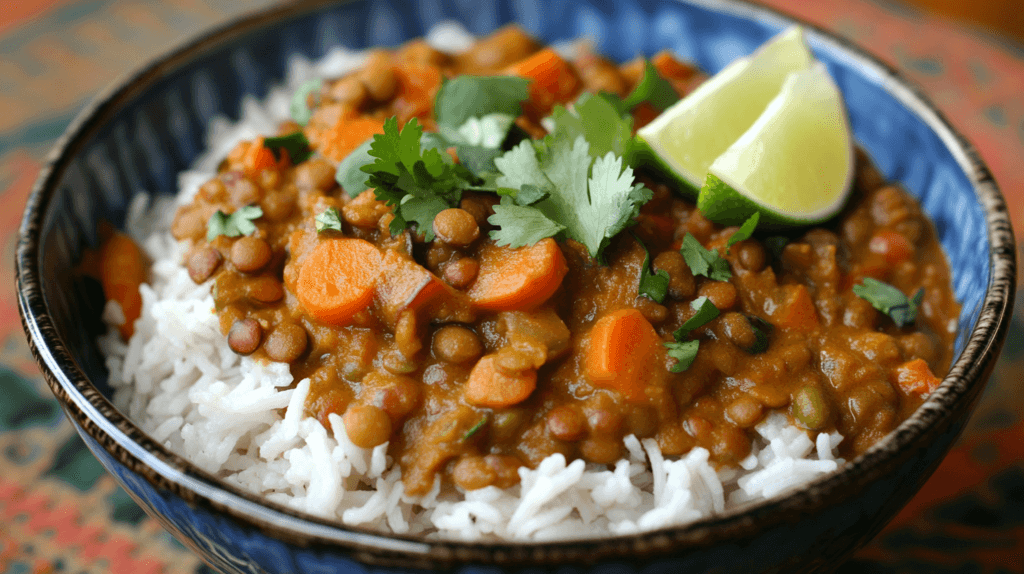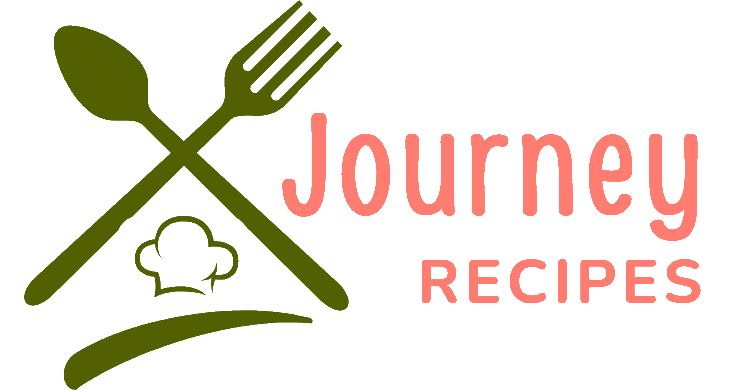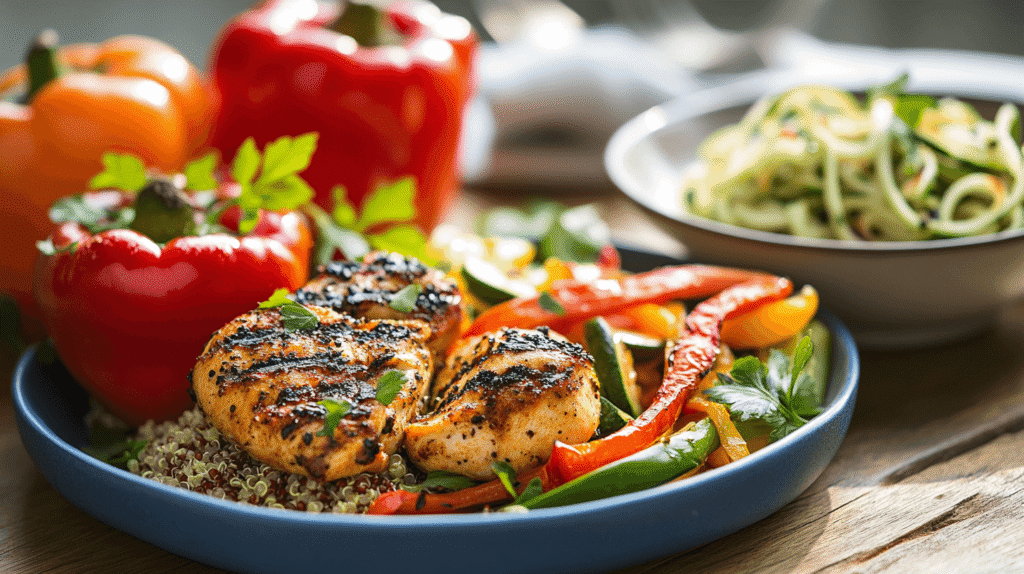Gluten Free Dinner Recipes are a must-have for anyone looking to enjoy delicious, healthy meals without gluten. Whether you’re managing celiac disease, gluten sensitivity, or simply exploring gluten-free cooking, these recipes offer something for everyone. Gone are the days of bland or overly restrictive meals—gluten-free dinners can be flavorful, creative, and satisfying for the whole family.
For those who need to avoid gluten for medical reasons, sticking to a gluten-free diet is essential for overall health. Beyond that, more people are turning to gluten-free meals for better digestion, increased energy, and cleaner eating. This guide is your ultimate resource for creating delightful gluten-free dishes, with quick recipes, comforting classics, and even kid-friendly options. Ready to transform your dinner menu? Let’s dive in!
Table of Contents
What Is Gluten-Free Cooking?
Definition of Gluten and Gluten-Free
Gluten is a type of protein found in wheat, barley, rye, and related grains. It’s what gives bread its elasticity and pasta its chewy texture. While gluten may seem harmless, it can cause adverse reactions in people with celiac disease, gluten intolerance, or wheat allergies.
Gluten-free cooking, therefore, involves eliminating all sources of gluten from your meals. This doesn’t just mean avoiding bread and pasta—it also includes being mindful of hidden gluten in processed foods, sauces, and even some seasonings.
Why People Choose Gluten-Free Diets
There are several reasons why someone might opt for a gluten-free diet:
- Celiac Disease: An autoimmune disorder where consuming gluten damages the small intestine.
- Non-Celiac Gluten Sensitivity: Symptoms like bloating, headaches, and fatigue after eating gluten.
- Wheat Allergy: A reaction to proteins in wheat that can trigger allergy symptoms.
- Personal Choice: Some people feel that going gluten-free improves their digestion and overall energy levels.
Regardless of the reason, a gluten-free diet can open the door to discovering new ingredients and creative ways to enjoy meals.
Overview of Common Gluten-Free Ingredients
The foundation of gluten-free cooking lies in swapping traditional ingredients for alternatives that don’t contain gluten. Some popular gluten-free staples include:
- Grains: Quinoa, rice, millet, buckwheat, and sorghum.
- Flours: Almond flour, coconut flour, rice flour, and tapioca flour.
- Legumes and Beans: Lentils, chickpeas, and black beans.
- Starches: Potatoes, sweet potatoes, and cassava.
- Other Alternatives: Gluten-free bread, pasta, and breadcrumbs made from non-gluten grains.
By incorporating these ingredients into your meals, you’ll find that gluten-free cooking can be just as versatile and satisfying as traditional cooking.
Essential Tips for Gluten Free Dinner Recipes

Cooking gluten-free isn’t just about choosing the right ingredients—it’s also about taking extra care to ensure your meals are safe, delicious, and free from contamination. Here are some essential tips to keep in mind:
How to Avoid Cross-Contamination in the Kitchen
Cross-contamination happens when gluten-containing items come into contact with gluten-free foods. This is a significant concern for individuals with celiac disease or severe gluten intolerance. To prevent cross-contamination:
- Use Separate Utensils and Cookware: Dedicate specific cutting boards, knives, and pans for gluten-free cooking.
- Clean Thoroughly: Wash all surfaces, utensils, and cooking tools with hot, soapy water before using them for gluten-free preparation.
- Toaster Safety: Avoid using a shared toaster; invest in a separate one for gluten-free bread.
- Label Items: Clearly mark gluten-free products to keep them separate from regular ingredients.
Gluten-Free Substitutions for Common Ingredients
One of the most exciting parts of gluten-free cooking is discovering creative substitutions for traditional ingredients. Here are some popular swaps:
- Breadcrumbs: Replace regular breadcrumbs with crushed rice crackers, gluten-free breadcrumbs, or almond meal.
- Flour: Use gluten-free flour blends, almond flour, or coconut flour in place of all-purpose flour for baking or thickening sauces.
- Pasta: Swap wheat-based pasta for rice noodles, chickpea pasta, or spiralized vegetable noodles like zucchini or sweet potato.
- Soy Sauce: Traditional soy sauce contains wheat—use tamari or coconut aminos as a gluten-free alternative.
Reading Labels for Hidden Sources of Gluten
Gluten can hide in unexpected places, especially in processed foods. Always read the ingredient labels carefully to check for gluten-containing additives like:
- Hydrolyzed Wheat Protein
- Malt or Malt Extract
- Modified Food Starch (unless labeled gluten-free)
- Flavorings and Seasonings (e.g., some spice blends contain flour as a filler)
Look for products that are certified gluten-free to ensure they meet strict safety standards.
Quick and Easy Gluten Free Dinner Recipes
Life gets busy, but that doesn’t mean you need to sacrifice a healthy, gluten-free dinner! Here are a few quick and easy recipes that come together in no time:
Recipe 1: Grilled Lemon Garlic Chicken with Veggies
Ingredients Needed:
- 4 boneless, skinless chicken breasts
- 3 tablespoons olive oil
- Juice of 2 lemons
- 3 garlic cloves, minced
- 1 teaspoon dried oregano
- Salt and pepper, to taste
- 2 cups mixed vegetables (broccoli, zucchini, and bell peppers)
Instructions:
- In a small bowl, whisk together olive oil, lemon juice, garlic, oregano, salt, and pepper.
- Marinate the chicken breasts in the mixture for at least 20 minutes.
- Preheat a grill or grill pan over medium heat. Grill the chicken for 6–8 minutes per side or until fully cooked.
- Toss the mixed vegetables with a little olive oil, salt, and pepper. Grill them alongside the chicken for 5–7 minutes until tender.
- Serve the grilled chicken with the veggies on the side for a simple yet flavorful meal.
Recipe 2: Quinoa-Stuffed Bell Peppers
Ingredients Needed:
- 4 large bell peppers (any color)
- 1 cup cooked quinoa
- 1 cup diced tomatoes
- ½ cup black beans, drained and rinsed
- 1 cup shredded cheese (optional, or use dairy-free cheese)
- 1 teaspoon cumin
- 1 teaspoon paprika
- Salt and pepper, to taste
Instructions:
- Preheat the oven to 375°F (190°C). Slice off the tops of the bell peppers and remove the seeds.
- In a bowl, mix the cooked quinoa, diced tomatoes, black beans, cheese (if using), cumin, paprika, salt, and pepper.
- Stuff each bell pepper with the quinoa mixture and place them in a baking dish.
- Cover the dish with foil and bake for 30 minutes. Remove the foil and bake for an additional 10 minutes until the peppers are tender.
- Serve warm, garnished with fresh herbs if desired.
Recipe 3: Zucchini Noodles with Pesto and Shrimp
Ingredients Needed:
- 4 medium zucchinis, spiralized
- 2 cups shrimp, peeled and deveined
- 2 tablespoons olive oil
- ½ cup gluten-free pesto
- Salt and pepper, to taste
- Optional: Grated Parmesan cheese for garnish
Instructions:
- Heat olive oil in a large skillet over medium heat. Add the shrimp and cook for 2–3 minutes per side until pink and opaque. Season with salt and pepper.
- Remove the shrimp from the skillet and set aside. In the same skillet, lightly sauté the zucchini noodles for 2–3 minutes until tender.
- Toss the zucchini noodles with the gluten-free pesto until well coated. Add the shrimp back to the skillet and mix gently.
- Serve immediately, topped with Parmesan cheese if desired.
Gluten-Free Comfort Food Recipes
Who says comfort food can’t be gluten-free? These recipes deliver all the cozy, satisfying vibes you’re craving—without a trace of gluten.
Recipe 4: Gluten-Free Mac and Cheese
Ingredients Needed:
- 12 ounces gluten-free elbow pasta
- 2 tablespoons butter or dairy-free alternative
- 2 tablespoons gluten-free flour
- 2 cups milk or dairy-free milk
- 2 cups shredded cheddar cheese (or dairy-free cheese)
- 1 teaspoon Dijon mustard
- Salt and pepper, to taste
Instructions:
- Cook the gluten-free pasta according to the package instructions. Drain and set aside.
- In a saucepan, melt the butter over medium heat. Stir in the gluten-free flour and cook for 1–2 minutes to form a roux.
- Gradually whisk in the milk, stirring continuously to prevent lumps. Cook until the sauce thickens.
- Add the shredded cheese and Dijon mustard to the sauce, stirring until smooth. Season with salt and pepper.
- Combine the cheese sauce with the cooked pasta, mixing well. Serve immediately for a creamy, indulgent meal.
Recipe 5: Shepherd’s Pie with a Sweet Potato Twist
Ingredients Needed:
- 1 pound ground beef or turkey
- 1 onion, diced
- 2 carrots, diced
- 1 cup peas
- 2 tablespoons gluten-free Worcestershire sauce
- 1 tablespoon tomato paste
- 1 cup beef or vegetable broth
- 4 medium sweet potatoes, peeled and boiled
- 2 tablespoons butter or olive oil
- Salt and pepper, to taste
Instructions:
- Preheat the oven to 400°F (200°C).
- In a skillet, cook the ground beef or turkey over medium heat until browned. Add the onion and carrots, cooking until softened.
- Stir in the peas, Worcestershire sauce, tomato paste, and broth. Simmer for 5–7 minutes until the mixture thickens slightly.
- Mash the boiled sweet potatoes with butter or olive oil, adding salt and pepper to taste.
- Spread the meat mixture into a baking dish, then layer the mashed sweet potatoes on top. Smooth the surface with a spatula.
- Bake for 20–25 minutes, or until the top is lightly browned. Serve warm and enjoy this hearty dish!
Kid-Friendly Gluten-Free Dinners
Finding meals that kids love while sticking to a gluten-free diet can feel like a challenge, but these recipes are sure to be a hit with even the pickiest eaters.
Recipe 6: Gluten-Free Pizza with a Cauliflower Crust
Ingredients Needed:
- 1 medium head of cauliflower, grated (or 4 cups riced cauliflower)
- 1 egg
- ½ cup shredded mozzarella cheese (or dairy-free cheese)
- 1 teaspoon dried oregano
- 1 teaspoon garlic powder
- ½ cup pizza sauce
- Toppings of choice (pepperoni, veggies, etc.)
Instructions:
- Preheat the oven to 425°F (220°C) and line a baking sheet with parchment paper.
- Steam the riced cauliflower for 5 minutes, then squeeze out the excess moisture using a clean kitchen towel.
- In a bowl, mix the cauliflower, egg, cheese, oregano, and garlic powder to form a dough.
- Shape the dough into a pizza crust on the prepared baking sheet and bake for 10–12 minutes until golden.
- Spread the pizza sauce on the crust, add your toppings, and bake for another 8–10 minutes until the cheese is melted.
- Let it cool slightly before slicing.
Recipe 7: Chicken Tenders with Almond Flour Coating
Ingredients Needed:
- 1 pound chicken tenders
- 1 cup almond flour
- ½ teaspoon paprika
- ½ teaspoon garlic powder
- ½ teaspoon salt
- 2 eggs, beaten
- Olive oil for frying
Instructions:
- In a shallow dish, mix the almond flour, paprika, garlic powder, and salt.
- Dip each chicken tender into the beaten eggs, then coat with the almond flour mixture.
- Heat olive oil in a skillet over medium heat. Fry the chicken tenders for 3–4 minutes per side until golden brown and fully cooked.
- Serve with a gluten-free dipping sauce like honey mustard or ketchup.
Vegetarian and Vegan Gluten-Free Dinners

Plant-based meals can be both satisfying and gluten-free, packed with flavor and nutrients. These recipes are perfect for anyone seeking a meatless option.
Recipe 8: Lentil and Vegetable Curry
Ingredients Needed:
- 1 cup dried lentils, rinsed
- 1 tablespoon coconut oil
- 1 onion, diced
- 2 garlic cloves, minced
- 1 tablespoon grated ginger
- 1 teaspoon turmeric
- 1 teaspoon cumin
- 1 teaspoon curry powder
- 2 cups diced vegetables (carrots, zucchini, and bell peppers)
- 1 can (14 oz) coconut milk
- 1 can (14 oz) diced tomatoes
- 1 cup vegetable broth
- Fresh cilantro for garnish
Instructions:
- In a large pot, heat coconut oil over medium heat. Sauté the onion, garlic, and ginger until fragrant.
- Stir in the turmeric, cumin, and curry powder, cooking for 1 minute to release the flavors.
- Add the lentils, diced vegetables, coconut milk, diced tomatoes, and vegetable broth. Stir to combine.
- Bring to a boil, then reduce the heat and simmer for 20–25 minutes, or until the lentils are tender and the sauce thickens.
- Serve over steamed rice or quinoa, garnished with fresh cilantro.
Recipe 9: Gluten-Free Vegan Tacos
Ingredients Needed:
- 8 gluten-free taco shells or corn tortillas
- 1 can (14 oz) black beans, rinsed and drained
- 1 cup diced sweet potato, roasted
- 1 teaspoon chili powder
- ½ teaspoon smoked paprika
- ½ teaspoon garlic powder
- 1 avocado, sliced
- 1 cup shredded lettuce
- ½ cup salsa
- ½ cup vegan sour cream (optional)
Instructions:
- Heat a skillet over medium heat. Add the black beans, chili powder, smoked paprika, and garlic powder, stirring until the beans are warmed through and flavorful.
- Roast the diced sweet potatoes in the oven at 400°F (200°C) for 20–25 minutes until tender.
- Assemble the tacos: Fill each gluten-free shell with a mix of black beans, roasted sweet potato, avocado slices, shredded lettuce, and salsa. Top with vegan sour cream if desired.
- Serve immediately and enjoy the burst of flavors!
Benefits of Gluten-Free Eating
Switching to a gluten-free diet can bring numerous benefits, whether you’re managing a health condition or simply trying to eat more mindfully.
Improved Digestion
For individuals with gluten sensitivity or celiac disease, removing gluten can alleviate digestive issues like bloating, gas, and abdominal discomfort.
Supporting Specific Health Conditions
A gluten-free diet is a necessity for people with celiac disease, an autoimmune disorder that can damage the small intestine when gluten is consumed. It’s also helpful for those with wheat allergies or gluten sensitivity.
Versatility and Creativity in Cooking
One unexpected benefit of going gluten-free is discovering a whole new world of ingredients and recipes. From experimenting with alternative grains like quinoa and millet to finding creative uses for vegetables (like zucchini noodles or cauliflower pizza crust), gluten-free cooking can spark your creativity in the kitchen.
Common Gluten-Free Pantry Staples
Stocking your pantry with the right ingredients is key to making gluten-free meals with ease. Here’s what you should always have on hand:
Gluten-Free Grains
- Quinoa, rice (white, brown, or wild), millet, and buckwheat are naturally gluten-free and versatile for many dishes.
Gluten-Free Flours
- Almond flour, coconut flour, rice flour, and tapioca flour can be used for baking, thickening sauces, or breading.
Gluten-Free Sauces, Spices, and Condiments
- Tamari (a gluten-free soy sauce alternative), coconut aminos, gluten-free bouillon cubes, and spice blends labeled gluten-free are must-haves.
Other Pantry Essentials
- Gluten-free breadcrumbs, chickpea pasta, and canned legumes (like lentils and black beans) make quick meal prep a breeze.
FAQs
What are some hidden sources of gluten?
Gluten can be found in unexpected places like soy sauce, salad dressings, soups, and spice mixes. Always check labels for gluten-containing ingredients or opt for certified gluten-free products. For more tips, see our article on gluten-free options in Crumbl Cookies.
How do I ensure a balanced gluten-free meal?
A balanced gluten-free meal includes a variety of proteins, healthy fats, and gluten-free carbohydrates like rice, quinoa, or sweet potatoes. Adding plenty of fresh vegetables ensures you’re getting essential nutrients.
Are gluten-free recipes suitable for everyone?
Yes, gluten-free recipes are safe for everyone. However, individuals without gluten sensitivities or celiac disease may not need to avoid gluten entirely.
What can I use as a gluten-free thickener?
Arrowroot powder, cornstarch, and tapioca flour are excellent gluten-free alternatives for thickening soups, sauces, and gravies. Learn more about alternatives in our guide to thickening seafood boil sauces.
How do I store gluten-free leftovers safely?
Store gluten-free leftovers in airtight containers to prevent contamination. Label them clearly and refrigerate for up to 3 days, or freeze for longer storage. For practical tips, check out our piece on freezing Sinigang.
Conclusion
Gluten-free dinner recipes are more than just a dietary necessity—they’re an opportunity to explore delicious and creative ways of cooking. From quick meals like zucchini noodles with pesto to comforting dishes like gluten-free mac and cheese, there’s no shortage of options to satisfy every craving. By stocking your pantry with gluten-free staples and following essential tips, you’ll find that creating safe and tasty meals is easier than ever.
So, why not give these recipes a try? Gluten-free cooking can be simple, fun, and incredibly rewarding. Bon appétit!
Printable Recipe Card
Want just the essential recipe details without scrolling through the article? Get our printable recipe card with just the ingredients and instructions.

